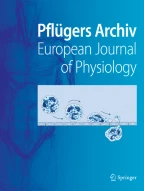Abstract.
KCNE1 (IsK, minK) co-assembles with KCNQ1 (KvLQT1) to form voltage-dependent K+ channels. Both KCNQ1 and KCNE1 are expressed in epithelial cells of gut and exocrine pancreas. We examined the role of KCNQ1/KCNE1 in Cl– secretion in small and large intestine and exocrine pancreas using the KCNE1 knockout mouse. Immunofluorescence revealed a similar basolateral localization of KCNQ1 in jejunum and colon of KCNE1 wild-type and knockout mice. Electrogenic Cl– secretion in the colon was not affected by gene disruption of KCNE1; in jejunum forskolin-induced short-circuit current was some 40% smaller but without being significantly different. Inhibition of KCNQ1 channels by 293B (IC50 1 µmol l–1) and by IKS224 (IC50 14 nmol l–1) strongly diminished intestinal Cl– secretion. In exocrine pancreas of wild-type mice, KCNQ1 was predominantly located at the basolateral membrane. In KCNE1 knockout mice, however, the basolateral staining was less pronounced and the distribution of secretory granules was irregular. A slowly activating and 293B-sensitive K+ current was activated via cholinergic stimulation in pancreatic acinar cells of wild-type mice. In KCNE1 knockout mice this K+ current was strongly reduced. In conclusion intestinal Cl– secretion is independent from KCNE1 but requires KCNQ1. In mouse pancreatic acini KCNQ1 probably co-assembled with KCNE1 leads to a voltage-dependent K+ current that might be of importance for electrolyte and enzyme secretion.
Similar content being viewed by others
Author information
Authors and Affiliations
Additional information
Electronic Publication
Rights and permissions
About this article
Cite this article
Warth, .R., Garcia Alzamora, .M., Kim, .J. et al. The role of KCNQ1/KCNE1 K+ channels in intestine and pancreas: lessons from the KCNE1 knockout mouse. Pflügers Arch - Eur J Physiol 443, 822–828 (2002). https://doi.org/10.1007/s00424-001-0751-3
Received:
Revised:
Accepted:
Issue Date:
DOI: https://doi.org/10.1007/s00424-001-0751-3
